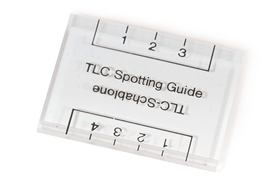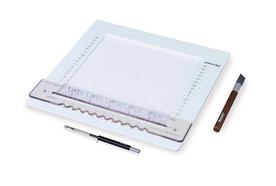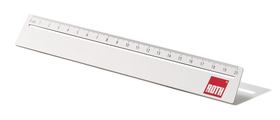Technical Data Sheet
TLC Plates POLYGRAM® CEL 400 / UV254, 20 x 20 cm, 25 unit(s)
€172.00/Pack Qty.
excl. VAT. | 25 unit(s) per Pack Qty.
Art. No. 1333.1
Fits to / Accessories
Product details
Microcrystalline cellulose, cellulose MN 400 (AVICEL®)
- Prepared by hydrolysis of high puritiy cellulose with HCl
- Mean degree of polymerisation: 40-200
Further attractive products to complete your chromatography laboratory can be found on our Chromatography page!
TLC Plates POLYGRAM® CEL 400 / UV254
| Plate format | 20 x 20 cm |
| Layer thickness | 0.1 mm |
| Material | polyester |
| Modification | Microcrystalline cellulose |
| Fluorescent indicator | yes |
| Separation principle | Normal phase (NP) |
| Phase | CEL 400 |
| Particle type | Fully porous particles (FPP) |
| pH stability | 2,0-8,0 |
| Temperature stability | High |
| Recommended application(s) | Carboxylic acids, lower alcohols, urea and purine derivatives |
- Subtotal: 0.00
| Art. No. | Plate format | Layer thickness | Pack Qty. | Price | Quantity | |
|---|---|---|---|---|---|---|
| 1332.1 | 5 x 20 cm | 0,1 mm | 50 unit(s) |
€109.65 |
|
|
| 1333.1 | 20 x 20 cm | 0,1 mm | 25 unit(s) |
€172.00 |
|
|
|
In stock
Available
In procurement
No longer available
Delivery date currently unknown
|
||||||
- Subtotal: 0.00
Downloads / MSDS
General information
Further attractive products to complete your chromatography laboratory can be found on our Chromatography page!
Although the principle of thin-layer chromatography is more than a century old, it did not make its breakthrough as an analytical method until about 50 years ago.
Thanks to the development of new sorbents and supports, as well as increasing instrumentation and automation, TLC has become a versatile separation method. It is used both in qualitative analysis and in quantitative analysis.
Applications range from simple manual separation processes in classic TLC to automated processes in HPTLC (high performance thin layer chromatography).
Advantages of thin layer chromatography:
- Higher sample throughput in less time
- Suitable for screening tests
- Pilot process for HPLC
- The ready-to-use TLC layer functions as a data storage device for separation results
- The separated substances can be used later for further analysis (e.g. IR, MS)
- By switching the mobile and the stationary phases, the separation process can be optimised quickly and cost-efficient






